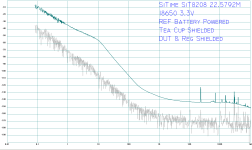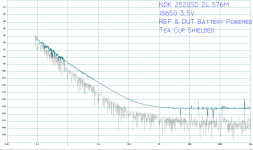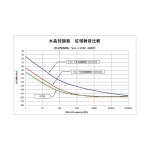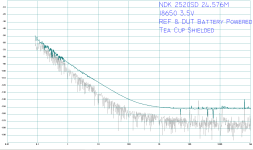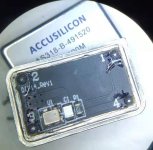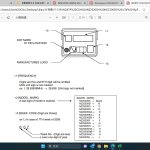Hello . I bought a Chinese board that resembles the original Amanero. I would like to put better oscillators for the sound. Can you help me with advice? What exactly would fit in the place of what is there? I have attached links to pictures of the plate below.
https://ibb.co/9TQ1wHM
https://ibb.co/zNMdBQ3
https://ibb.co/0DNL6wr
https://ibb.co/X44xRt2
https://ibb.co/9TQ1wHM
https://ibb.co/zNMdBQ3
https://ibb.co/0DNL6wr
https://ibb.co/X44xRt2
Last edited:
I am thinking of replacing them with SIT8008BC-81-33E-22.579200 and SIT1602BC-81-33E-24.576000 , but I saw that they work at 3.3V. It's ok ?
https://www.digikey.ro/en/products/detail/sitime/SIT8008BC-81-33E-22-579200/11706831
https://www.digikey.ro/en/products/detail/sitime/SIT1602BC-81-33E-24-576000/11296460
I saw that there are different models marked with E, S, N.
E - output enable
S - standby
N - not connecting
"A capacitor of value 0.1 µF or higher between Vdd and GND is required " - Does this mean that I have to add 1 more piece to the pcb board? Or is it not needed? I thought I was just replacing one oscillator with another without any other changes? I was wrong ?
https://www.digikey.ro/en/products/detail/sitime/SIT8008BC-81-33E-22-579200/11706831
https://www.digikey.ro/en/products/detail/sitime/SIT1602BC-81-33E-24-576000/11296460
I saw that there are different models marked with E, S, N.
E - output enable
S - standby
N - not connecting
"A capacitor of value 0.1 µF or higher between Vdd and GND is required " - Does this mean that I have to add 1 more piece to the pcb board? Or is it not needed? I thought I was just replacing one oscillator with another without any other changes? I was wrong ?
Last edited:
What is wrong with the original oscillators? Do you have the specifications of the original and the replacement parts?
I read that the sound can be improved if MEMS oscillators are installed.
This is JWT data . https://ibb.co/5c3XkPV
This is JWT data . https://ibb.co/5c3XkPV
If MEMS oscillators sound better then the original clocks must be pretty bad. MEMS are not ideal for dacs, in case that wasn't clear.
Anyway, the first thing to do to improve the sound usually is to run the USB board from clean +5v power, instead of from USB power. To do that there is a component near the USB connector labeled, L1. If it is removed then clean +5v can be connected to the L1 pad nearest to C2. Ground for the clean supply should be connected to the ground plane on the bottom of the PCB. If needed a little of the solder mask can be scraped off the bottom of the board ground plane so a clean power ground can be soldered there.
Otherwise, a USB cable can be modified to bring clean +5 power in through the USB connector.
Anyway, the first thing to do to improve the sound usually is to run the USB board from clean +5v power, instead of from USB power. To do that there is a component near the USB connector labeled, L1. If it is removed then clean +5v can be connected to the L1 pad nearest to C2. Ground for the clean supply should be connected to the ground plane on the bottom of the PCB. If needed a little of the solder mask can be scraped off the bottom of the board ground plane so a clean power ground can be soldered there.
Otherwise, a USB cable can be modified to bring clean +5 power in through the USB connector.
I wouldn't consider SiTime oscillators as they are not good performers on audio. Instead, the NDK NZ2520SD series will give you more bang for your buck. It's hard to beat the NDK in terms of price. Here are the phase noise measurments from my own oscillators. Not quite a direct comparison, but you got the picture.
Attachments
Last edited:
I have a small number of NDK SDA that were hand selected by Jocko Homo. He said that about 1 out of 10 were especially good. He would keep the best ones and sell the rejects on ebay. Only point is that you can get lucky or not. Also, IME it matters how clocks are powered, bypassed, and buffered. There are lots of ways to make phase noise worse in a dac than is seen in a test fixture. Regarding replacing the clocks on a USB board, they will be buffered by a CPLD chip, so there goes the phase noise anyway. Also, most USB boards don't leave both clocks running all the time, rather they use the enable pin on the clocks to turn off the clock that isn't being used. At it turns out crystal oscillators tend to stabilize over time if always left running.
Bottom line is that its best to use USB boards that can accept external clocks, then make a clock board that also reclocks the USB board I2S outputs. By that means CPLD jitter can avoided for MCLK, and cleaned up for I2S bus signals.
Bottom line is that its best to use USB boards that can accept external clocks, then make a clock board that also reclocks the USB board I2S outputs. By that means CPLD jitter can avoided for MCLK, and cleaned up for I2S bus signals.
Last edited:
Yes, I also heard about that. I got my NDK from DIYINHK years ago. It's definitely not hand picked, but very close to the test curve from manufacturer. I think most of them should meet the specification. I'd like to know what exceptional ones look like ^_^...NDK SDA that were hand selected by Jocko Homo. He said that about 1 out of 10 were especially good.
Attachments
Last edited:
Don't know if the phase noise graph produced by NDK is intended as a specification or not. What they show as presumably typical performance is not included the actual datasheet.
They also once claimed to have an SOA set of oscillators at audio frequencies. Don't know what ever happened to those.
Documents from my archives attached below.
Then of course there are the Accusilicon clocks...
They also once claimed to have an SOA set of oscillators at audio frequencies. Don't know what ever happened to those.
Documents from my archives attached below.
Then of course there are the Accusilicon clocks...
Attachments
Hi,
I finally acquired the AS318B from Accusilicon. FYR, here is the phase noise plot from my measurement. I'd say the AS318B is a good alternative to NDK SDA series. By the way, the discountinued NDK SD series did show different performance from batch to batch. The later batch shows lower noise level than early batch. I suspected they are in fact SDA. NDK says you can't distinguish them from the marking as they are identical. I guess they somehow changed the design and later decided to promote them as SDA series.

I finally acquired the AS318B from Accusilicon. FYR, here is the phase noise plot from my measurement. I'd say the AS318B is a good alternative to NDK SDA series. By the way, the discountinued NDK SD series did show different performance from batch to batch. The later batch shows lower noise level than early batch. I suspected they are in fact SDA. NDK says you can't distinguish them from the marking as they are identical. I guess they somehow changed the design and later decided to promote them as SDA series.
I got NDK from digikey recently. The serial number is 31X, but the SDA seems to be 74X.
My question is how to distinguish between SD and SDA.
My question is how to distinguish between SD and SDA.
Thanks for your reply.
Unfortunately, maybe it's just old SD made in 2013. I guess that the new SDA was produced in 2017.
Unfortunately, maybe it's just old SD made in 2013. I guess that the new SDA was produced in 2017.
IIUC the NDK SDAs were being manufactured in the AKM factory that was destroyed by fire. There was reported to be a shortage of NDK SDA for awhile until they established new production elsewhere.
Also, could be SD and SDA have the same markings because SDA were binned from SD after manufacturing.
Also, could be SD and SDA have the same markings because SDA were binned from SD after manufacturing.
Canvas, very nice clean measurements! May I ask your test setup.. looks somehow familiar.. Holme?
As for the AS318, thanks! Though it looks like 6 -10dB worse results then your NDK SD plot, even after 6dB subtraction for the double test frequency..
As for the AS318, thanks! Though it looks like 6 -10dB worse results then your NDK SD plot, even after 6dB subtraction for the double test frequency..
- Home
- Source & Line
- Digital Line Level
- Upgrade oscillators in a Chinese - (not original) Amanero board
